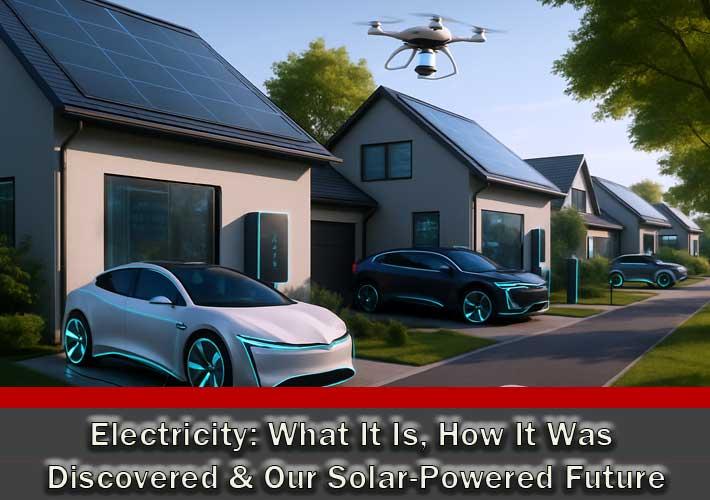 Add My Company
Add My Company

Electricity is all around us – from the lights in our homes to the phones in our pockets – but it wasn’t always well understood. In this article, we’ll break down what electricity is in simple terms, trace its historical discovery, introduce key figures like Alessandro Volta, and explore how creatures like electric eels inspired early experiments. We’ll also look at how the “giant kettle” analogy helps explain modern power generation, and what a future powered by solar energy could look like.
What Is Electricity?
Electricity is the movement or presence of electric charge, most often involving electrons flowing through a conductor like copper wire. This flow, called an electric current, powers everything from lights to computers. Flick a switch, and you’re setting electrons in motion to make something work.
You’ve likely experienced static electricity – when your hair stands on end after rubbing a balloon on your head. This happens because electrons are transferred from one surface to another, creating an imbalance in electric charge. The balloon becomes negatively charged, attracting your positively charged hair.
In nature, lightning is a massive spark of static electricity caused by charge differences in clouds and the ground. It’s a powerful reminder that electricity is a natural force as well as a man-made tool.
To better understand electricity, think of it like water in a pipe. Voltage is the pressure pushing water (or electrons), and current is the flow rate. This analogy helps explain how electricity behaves, even though we can’t see it directly.
Early Discoveries and Ancient Encounters
Humans have known about electric phenomena for thousands of years. Around 600 BC, the Greek philosopher Thales of Miletus noticed that rubbing amber with fur attracted small objects like feathers. The term “electricity” later came from the Greek word for amber, elektron.
In the 1600s, English scientist William Gilbert explored magnetism and coined the term “electricity” in a more scientific context. By the 1700s, devices like the Leyden jar – an early capacitor – were invented to store static charges. Electricity was becoming more than just a curiosity.
One of the most famous early experiments came in 1752, when Benjamin Franklin flew a kite in a thunderstorm, drawing sparks from a key tied to the string. This proved that lightning and the static electricity produced in labs were the same phenomenon – a shocking and dangerous revelation at the time.
Meanwhile, natural electric creatures intrigued scientists. Ancient civilisations knew that electric eels and rays could deliver a jolt. In the 1770s, British researcher John Walsh studied these fish and showed they could produce sparks and charge Leyden jars. This confirmed that electricity wasn’t just mechanical – it also existed in living organisms.
Volta, Galvani, and the Birth of the Battery
In the late 18th century, Italian scientist Luigi Galvani discovered that frog legs twitched when touched by metal. He believed in “animal electricity” – the idea that living tissue produced its own electric force.
His rival, Alessandro Volta, disagreed. He thought the electricity came from the combination of metals and bodily fluids, not the frog itself. To test this, he invented the voltaic pile in 1800 – the world’s first battery. It used alternating discs of copper and zinc separated by saltwater-soaked pads to produce a continuous electric current.
Inspired in part by electric fish, Volta’s invention created the first steady, reliable source of electricity. This allowed scientists to move beyond static sparks and begin serious exploration of electrochemistry and electromagnetism. Today, we honour Volta with the unit “volt”.
The “Big Kettle” Analogy: How Power Stations Work
So how do we go from Volta’s battery to powering entire cities?
In most power stations, electricity is generated by boiling water. The heat source might be coal, gas, nuclear fuel or even sunlight (in the case of solar thermal plants). The water turns to steam, which spins a turbine. This turbine is connected to a generator, where magnets rotate inside coils of wire, creating electricity through electromagnetic induction – a principle discovered by Michael Faraday in 1831.
It’s like a massive kettle heating up water, with the steam powering a mechanical fan. That motion turns into electric energy, which is then sent through the National Grid to our homes and businesses.
Think of the grid like a system of pipes: the voltage is water pressure, and the current is water flow. Transformers adjust the voltage up for long-distance travel, then down again for safe use at home. The system must stay balanced – supply and demand must match exactly in real time, or power cuts and faults occur.
Some renewable sources skip the kettle. Hydropower uses flowing water, wind turbines use the wind, and solar panels convert sunlight directly into electricity. But even some solar farms work like kettles – using mirrors to heat fluid and create steam.
The Road to a Solar Future
Can we power the world entirely with solar energy? It’s possible in theory. The Sun delivers enough energy to Earth in one hour to meet global electricity demand for a whole year. The challenge lies in harnessing and storing it efficiently.
Imagine every home fitted with solar panels and a home battery. These batteries could charge during the day or from cheap off-peak electricity (sometimes as low as 7p per kWh at night). They’d power lights, appliances, and EV chargers, even after sunset.
Communities could be linked to solar farms and shared battery banks. Excess electricity generated during the day could be stored or even sold back to the grid. This vision of energy independence is already becoming a reality in parts of the UK.
However, solar energy isn’t always available – clouds, night-time and winter reduce output. That’s where energy storage becomes crucial. Batteries are improving, and other technologies like pumped hydro, thermal storage, and even hydrogen are being explored.
Solar power is flexible and scalable – it works on rooftops, calculators, and massive farms alike. As technology advances, prices fall and grid systems become smarter, solar is expected to form a growing part of the UK’s energy mix.
Some areas will always need backup from wind, hydro or nuclear, especially in darker, cloudier regions. But the potential for solar to cover a substantial share of our needs is clear – we just need to make it efficient, reliable and affordable.
Conclusion
Electricity, once a mysterious force observed in amber and lightning, is now central to our lives. From Galvani’s twitching frog legs to Volta’s pioneering battery, the journey of discovery has been extraordinary. The “big kettle” principle still powers much of our world – whether heated by fossil fuels, nuclear reactions or concentrated sunlight.
As we move towards a cleaner future, solar energy promises to play a leading role. With smart grids, home storage, and community sharing, we may one day live in a world where electricity is not only plentiful and sustainable, but generated just above our heads – courtesy of the Sun.
For more information on Electricity: What It Is, How It Was Discovered & Our Solar-Powered Future talk to Expert Electrical Supplies Ltd

